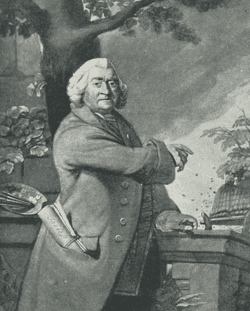James Worsdale, Portrait Painter
(b.
about 1692, d. 1767)Portrait Painter
From A Dictionary of Irish Artists 1913

James Worsdale. Mezzotint, by W. Dickinson, after R. E. Pine.
Born about 1692, he is reputed to have been a natural son of Sir Godfrey Kneller, whose pupil he was. Having secretly married a niece of Sir Godfrey's wife, he was dismissed and made his way to Ireland, where he obtained a considerable amount of patronage, more by his social qualities, his conviviality and humour, than by his skill as a painter. He was befriended by Lord Blayney, and particularly by Lawrence Parsons, 1st Earl of Rosse, with whom he was concerned in founding the Hell-Fire Club in 1735. For one of the members of this club, Henry Barry, 4th Lord Santry, he painted a portrait group of five of the members, which long hung at Santry Court and is now in the National Gallery of Ireland. He also painted, among other prominent personages, two portraits in 1738 and 1740 of the Lord Lieutenant, the Duke of Devonshire, one for Mrs. Conolly of Castletown, the other for the Royal Hospital.
Pasquin tells us that "it was his custom when a portrait was finished and not paid for to chalk the surface over with intersected lines, which conveyed the appearance of the subject being in prison, and this was exhibited continually in his painting-room until shame or pride induced the parties concerned to liberate the effigy by paying the artist." In 1741 Luke Gardiner, Master of the Revels, appointed Worsdale his deputy, a position which gave him some authority over the Dublin theatre. He had already written not only many songs and ballads, but several plays, including "A Cure for a Scold," a ballad-farce, in 1735, in which he himself appeared in the part of Manly at the Aungier Street theatre in 1741, and "The Assembly," a farce, in which he also took part. For a satire printed in Dublin in 1740 he instituted a suit for libel against the supposed authors, who were however acquitted. The libel complained of was contained in these lines:
Tho' Worsdale is for satire too obscure,
Must he uncensured artfully procure?
Frequent, as Painter, his employer's house,
And thence delude his mistress or his spouse?
True to the lover's procreating cause
He breaks all ties, all hospitable laws,
And pimps, resistless, while his pencil draws.
Returning to England he for some time belonged to a provincial company of players at Chester, and was afterwards, through the influence of Sir Edward Walpole, appointed master-painter to the Board of Ordnance. He died in London on the 13th June, 1767, aged 75, and was buried at St. Paul's, Covent Garden, where on his tombstone was inscribed his epitaph, written by himself:
Eager to get, but not to keep, the pelf,
A friend to all mankind except himself.
His portrait, painted by R. E. Pine, was engraved in mezzotint by William Dickinson. Amongst Worsdale's pictures are:
Lady Coningsly. Painted in 1737. In collection of F. Hanbury Williams, sold at Christie's, 17th March, 1888.
William, Duke of Devonshire, Lord Lieutenant. Painted in Dublin in 1738 for Mrs. Conolly.
William, Duke of Devonshire. Painted in Dublin in 1740 for the Royal Hospital. (A portrait of the Duke, probably one of these, was engraved in mezzotint by John Brooks.)
Samuel Grey, Commissioner of Revenue in Ireland. Engraved in mezzotint by John Brooks.
Sir John Ligonier. Painted in 1756; engraved in mezzotint by G. Bockman.
Princess Louisa. Engraved in mezzotint by G. Bockman.
Princess Mary. Engraved in mezzotint by G. Bockman.
Richard Nash. Engraved in mezzotint by G. Bockman.
Sir Thomas Pengelly. Engraved in mezzotint by J. Faber.
Hon. Mrs, Ponsonby. Engraved in mezzotint by J. Brooks, 1744.
Lord Quarrendon. [Viscount Dillon, Ditchley.]
Thomas Southerne, the dramatist. Was in the collection of the Earl of Cork sold at Christie's, 25th November, 1905. Engraved in mezzotint by J. Simon; also engraved, 8vo, by A. Bannerman.
Sir G. Hanbury Williams. Painted in 1737. In collection of F. Hanbury Williams, sold at Christie's, 17th March, 1888.
The Hell-Fire Club. [National Gallery of Ireland.] A group of five full-length figures seated or standing round a table; portraits of Henry Barry, 4th Lord Santry; Colonel Clements, Colonel Ponsonby, Colonel St. George, and Mr. Luttrell. The picture, 6 feet 10 inches by 9 feet, was probably painted between 1735 and 1738. It was formerly at Santry Court, the seat of the Domvile family, and was exhibited at South Kensington in 1867 by Sir Charles Domvile, Bart. At the sale of his collection it was purchased by Mr. John Wardell, of Dublin, after whose death it was, in accordance with his wishes, presented by his son to the National Gallery of Ireland in 1878. The picture was formerly erroneously attributed to Stephen Slaughter.
« William Woodhouse | Contents and Search | Joseph Michael Wright »
